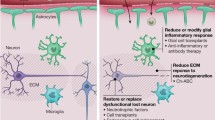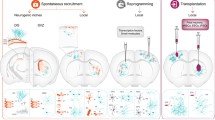Abstract
The reconstruction of damaged brain tissue is desirable because brain damage constitutes a major area of unmet medical need. In the view of some advocates, the cell therapy approaches that will lead to the reconstruction of damaged brain tissue will also enhance brain function in normal people. Although the meeting of unmet medical need appears laudable, human enhancement is viewed by some as a threat, but is brain reconstruction achievable whether desirable or not? This article argues that the prospects for true regenerative medicine in the brain are considerably exaggerated. Although current studies may lead to clinical advancement, progress on true reconstruction is very limited. I argue that brain reconstruction might prove to be an example of genuine biological impossibility.
Similar content being viewed by others
Notes
This experiment is routinely performed with mouse ES cells, and is the ultimate test of pluripotentiality. It would, however, be unethical to engraft human ES cells in this way, so we have to take on trust this ultimate proof of the pluripotentiality of human ES cells.
For example, ‘It is not impossible to build a human brain and we can do it in 10 years’ claims Henry Markham of the Ecole Polytechnique Fédérale de Lausanne. Quoted by Sejnowski (2010) www.scientificamerican.com/article.cfm?id=when-build-brains-like-ours.
References
Arlotta, P., Molyneaux, B.J., Chen, J., Inoue, J., Kominami, R. and Macklis, J.D. (2005) Neuronal subtype-specific genes that control corticospinal motor neuron development in vivo. Neuron 45: 207–221.
Arvidsson, A. et al (2002) Neuronal replacement from endogenous precursors in the adult brain after stroke. Nature Medicine 8: 963–970.
Barth, T.M. and Stanfield, B.B. (1994) Homotopic, but not heterotopic, fetal cortical transplants can result in functional sparing following neonatal damage to the frontal cortex in rats. Cerebral Cortex 4: 271–278.
Ben-Shaanan, T.L., Ben-Hur, T. and Yanai, J. (2008) Transplantation of neural progenitors enhances production of endogenous cells in the impaired brain. Molecular Psychiatry 13: 222–231.
Bible, E., Chau, D.Y.S., Alexander, M.R., Price, J., Shakesheff, K.M. and Modo, M. (2009) The support of neural stem cells transplanted into stroke-induced brain cavities by PLGA particles. Biomaterials 30: 2985–2994.
Boldrini, M. et al (2009) Antidepressants increase neural progenitor cells in the human hippocampus. Neuropsychopharmacology 34: 2376–2389.
Brockes, J.P. and Kumar, A. (2005) Appendage regeneration in adult vertebrates and implications for regenerative medicine. Science 310: 1919–1923.
Cummings, B.J. et al (2005) Human neural stem cells differentiate and promote locomotor recovery in spinal cord-injured mice. Proceedings of the National Academy of Sciences of the United States of America 102: 14069–14074.
Curtis, M.A., Faull, R.L.M. and Eriksson, P.S. (2007) The effect of neurodegenerative diseases on the subventricular zone. Nature Reviews Neuroscience 8: 712–723.
Doetsch, F. and Scharff, C. (2001) Challenges for brain repair: Insights from adult neurogenesis in birds and mammals. Brain, Behavior and Evolution 58: 306–322.
Duggan, P.S. et al (2009) Unintended changes in cognition, mood, and behavior arising from cell-based interventions for neurological conditions: Ethical challenges. American Journal of Bioethics 9: 31–36.
Fishell, G. and Hanashima, C. (2008) Pyramidal neurons grow up and change their mind. Neuron 57: 333–338.
Fukuyama, F. (2002) Our Posthuman Future. London: Profile Books.
Ghosh, A., Antonini, A. and McConnell, S.K. (1990) Requirement for subplate neurons in the formation of thalamocortical connections. Nature 347: 179–181.
Gurdon, J.B. (1974) The Control of Gene Expression in Animal Development. Oxford, UK: Oxford University Press.
Hagmann, P. et al (2008) Mapping the structural core of human cerebral cortex. Plos Biology 6: 1479–1493.
Harris, J. (2007) Enhancing Evolution: The Ethical Case for Making Better People. Princeton, NJ: Princeton University Press.
Heins, N. et al (2002) Glial cells generate neurons: The role of the transcription factor Pax6. Nature Neuroscience 5: 308–315.
Hochedlinger, K. (2010) Your inner healers. Scientific American 302: 46–53.
Hodges, H., Watts, H. and Reuter, I. (2003) Stem cells: Prospects for functional repair of brain damage. Transplantation Proceedings 35: 1250–1255.
Holtmaat, A. and Svoboda, K. (2009) Experience-dependent structural synaptic plasticity in the mammalian brain. Nature Reviews Neuroscience 10: 647–658.
Kaslin, J., Ganz, J. and Brand, M. (2008) Proliferation, neurogenesis and regeneration in the non-mammalian vertebrate brain. Philosophical Transactions of the Royal Society B-Biological Sciences 363: 101–122.
Kernie, S.G. and Parent, J.M. (2010) Forebrain neurogenesis after focal Ischemic and traumatic brain injury. Neurobiology of Disease 37: 267–274.
Kolb, B. et al (2007) Growth factor-stimulated generation of new cortical tissue and functional recovery after stroke damage to the motor cortex of rats. Journal of Cerebral Blood Flow and Metabolism 27: 983–997.
Kubinova, S. et al (2010) The use of superporous Ac-CGGASIKVAVS-OH-modified PHEMA scaffolds to promote cell adhesion and the differentiation of human fetal neural precursors. Biomaterials 31: 5966–5975.
Lentzos, F., Bennett, G., Boeke, J., Endy, D. and Rabinow, P. (2008) Roundtable on synthetic biology: Visions and challenges in redesigning life. BioSocieties 3: 311–323.
Liu, F. et al (2009a) Brain injury does not alter the intrinsic differentiation potential of adult neuroblasts. Journal of Neuroscience 29: 5075–5087.
Liu, Y.P. et al (2009b) Identification of small-molecule modulators of mouse SVZ progenitor cell proliferation and differentiation through high-throughput screening. Journal of Biomolecular Screening 14: 319–329.
Ming, G.L. and Song, H.J. (2005) Adult neurogenesis in the mammalian central nervous system. Annual Review of Neuroscience 28: 223–250.
Moskowitz, M.A., Lo, E.H. and Iadecola, C. (2010) The science of stroke: Mechanisms in search of treatments. Neuron 67: 181–198.
Nakatomi, H. et al (2002) Regeneration of hippocampal pyramidal neurons after ischemic brain injury by recruitment of endogenos neural progenitors. Cell 110: 429–441.
Nudo, R.J. (2006) Mechanisms for recovery of motor function following cortical damage. Current Opinion in Neurobiology 16: 638–644.
Orive, G., Anitua, E., Pedraz, J.L. and Emerich, D.F. (2009) Biomaterials for promoting brain protection, repair and regeneration. Nature Reviews Neuroscience 10: 682–692.
Park, K.I., Teng, Y.D. and Snyder, E.Y. (2002) The injured brain interacts reciprocally with neural stem cells supported by scaffolds to reconstitute lost tissue. Nature Biotechnology 20: 1111–1117.
Pluchino, S. et al (2005) Neurosphere-derived multipotent precursors promote neuroprotection by an immunomodulatory mechanism. Nature 436: 266–271.
Pollock, K. et al (2006) A conditionally immortal clonal stem cell line from human cortical neuroepithelium for the treatment of ischemic stroke. Experimental Neurology 199: 143–155.
Quednow, B.B. (2010) Ethics of neuroenhancement: A phantom debate. BioSocieties 5: 153–156.
Rakic, P. (2004) Neuroscience: Immigration denied. Nature 427: 685–686.
Roitbak, T., Li, L. and Cunningham, L.A. (2008) Neural stem/progenitor cells promote endothelial cell morphogenesis and protect endothelial cells against ischemia via HIF-1 alpha-regulated VEGF signaling. Journal of Cerebral Blood Flow and Metabolism 28: 1530–1542.
Rubin, B.P. (2009) Changing brains: The emergence of the field of adult neurogenesis. BioSocieties 4: 407–424.
Sanai, N. et al (2004) Unique astrocyte ribbon in adult human brain contains neural stem cells but lacks chain migration. Nature 427: 740–744.
Sejnowski, T. (2010) When will we be able to build brains like ours? Scientific American, http://scientificamerican.com/article.cfm?id=when-build-brains-likeours, accessed 27 April 2010.
Takahashi, K. and Yamanaka, S. (2006) Induction of pluripotent stem cells from mouse embryonic and adult fibroblast cultures by defined factors. Cell 126: 663–676.
Tanaka, E.M. and Ferretti, P. (2009) Considering the evolution of regeneration in the central nervous system. Nature Reviews Neuroscience 10: 713–723.
Vierbuchen, T., Ostermeier, A., Pang, Z.P., Kokubu, Y., Sudhof, T.C. and Wernig, M. (2010) Direct conversion of fibroblasts to functional neurons by defined factors. Nature 463: 1035–1041.
Zhang, Z.G. and Chopp, M. (2009) Neurorestorative therapies for stroke: Underlying mechanisms and translation to the clinic. Lancet Neurology 8: 491–500.
Acknowledgements
The author's own work cited in this report was supported by the NIH, the Charles Wolfson Charitable Trust; the European Commission; and the Wellcome Trust.
Author information
Authors and Affiliations
Rights and permissions
About this article
Cite this article
Price, J. Reconstructing brains: A biological impossibility?. BioSocieties 6, 299–322 (2011). https://doi.org/10.1057/biosoc.2011.6
Published:
Issue Date:
DOI: https://doi.org/10.1057/biosoc.2011.6




